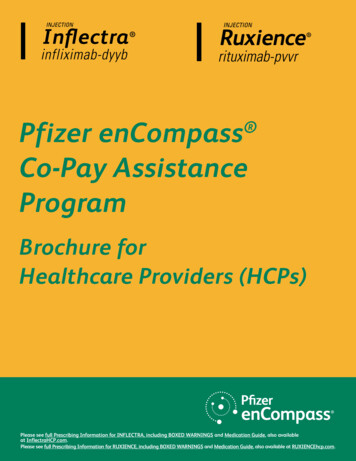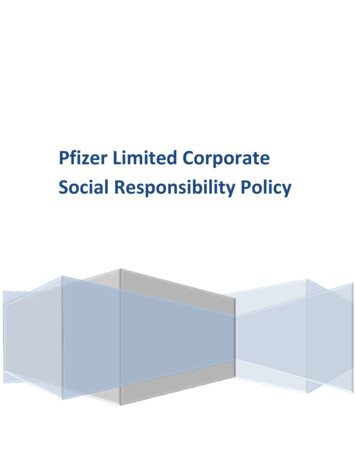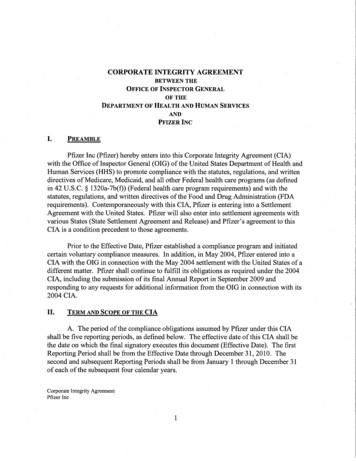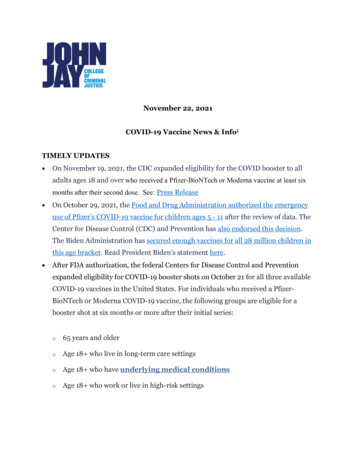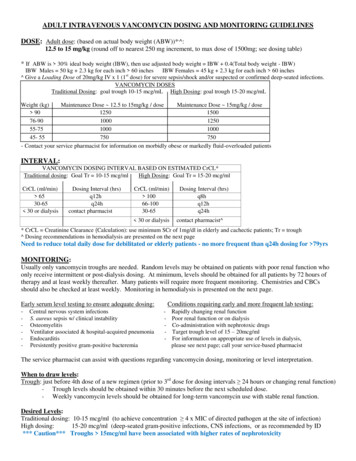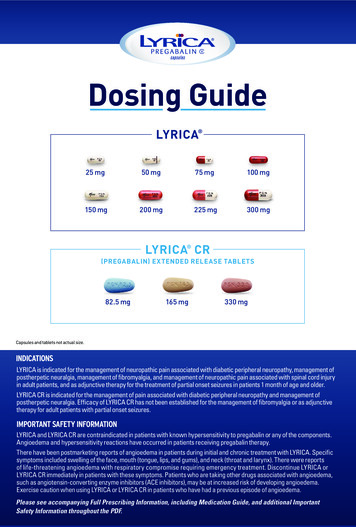
Transcription
Dosing GuideLYRICA 25 mg50 mg75 mg100 mg150 mg200 mg225 mg300 mgLYRICA CR(PREGABALIN) EXTENDED RELEASE TABLETS82.5 mg165 mg330 mgCapsules and tablets not actual size.INDICATIONSLYRICA is indicated for the management of neuropathic pain associated with diabetic peripheral neuropathy, management ofpostherpetic neuralgia, management of fibromyalgia, and management of neuropathic pain associated with spinal cord injuryin adult patients, and as adjunctive therapy for the treatment of partial onset seizures in patients 1 month of age and older.LYRICA CR is indicated for the management of pain associated with diabetic peripheral neuropathy and management ofpostherpetic neuralgia. Efficacy of LYRICA CR has not been established for the management of fibromyalgia or as adjunctivetherapy for adult patients with partial onset seizures.IMPORTANT SAFETY INFORMATIONLYRICA and LYRICA CR are contraindicated in patients with known hypersensitivity to pregabalin or any of the components.Angioedema and hypersensitivity reactions have occurred in patients receiving pregabalin therapy.There have been postmarketing reports of angioedema in patients during initial and chronic treatment with LYRICA. Specificsymptoms included swelling of the face, mouth (tongue, lips, and gums), and neck (throat and larynx). There were reportsof life-threatening angioedema with respiratory compromise requiring emergency treatment. Discontinue LYRICA orLYRICA CR immediately in patients with these symptoms. Patients who are taking other drugs associated with angioedema,such as angiotensin-converting enzyme inhibitors (ACE inhibitors), may be at increased risk of developing angioedema.Exercise caution when using LYRICA or LYRICA CR in patients who have had a previous episode of angioedema.Please see accompanying Full Prescribing Information, including Medication Guide, and additional ImportantSafety Information throughout the PDF.
Consider your next steps for LYRICA and LYRICA CR (pregabalin)extended release tablets titration, based on efficacy and tolerabilityLYRICASTARTINGDOSE (mg/day)DPNFM150150*(50 mg TID)MINIMUMRECOMMENDEDDOSE (mg/day)MAXIMUMRECOMMENDEDDOSE (mg/day)*300NeP SCI150150**(75 mg BID)(Divided BIDor TID)(75 mg BID)300†300‡300§(150 mg BID)(100 mg TID)PHN450(225 mg BID)(Divided BIDor TID)600(Divided BIDor TID)LYRICA CRSTARTINGDOSE (mg/day)165 165 (Once daily)(Once daily)330¶(Once daily)MAXIMUMRECOMMENDEDDOSE (mg/day)330(Once daily)660(2 x 330 mg,once daily)When discontinuing LYRICA CR, tapergradually over a minimum of 1 weekDPN diabetic peripheral neuropathy; FM fibromyalgia; NeP SCI neuropathic painassociated with spinal cord injury; PHN postherpetic neuralgia.IMPORTANT SAFETY INFORMATION (cont’d)For patients who do notexperience sufficient benefitwith 300 mg/day, the dosagemay be increased to450 mg/day.‡Patients who do notexperience sufficient benefitwith 300 mg/day after 2 to 4weeks of treatment and whoare able to tolerate LYRICAmay be titrated up to600 mg/day.600(300 mg BID)Patients who do notexperience sufficient benefitwith 300 mg/day after 2 to 3weeks of treatment and whoare able to tolerate LYRICAmay be titrated up to600 mg/day.§Dosage maybe increasedfrom 165 mg/dayto 330 mg/daybased on efficacyand tolerabilitywithin 1 week.LYRICA CR should be administeredonce daily after an evening meal.It should be swallowed whole andshould not be split, crushed,or chewed.Patients who donot experiencesufficient painrelief with330 mg/dayafter 2 to 4weeks oftreatment andwho are ableto tolerateLYRICA CR maybe titrated up to660 mg/day.Instruct patients that if they misstaking their dose of LYRICA CR after anevening meal, then they should taketheir usual dose of LYRICA CR prior tobedtime following a snack. If they misstaking the dose of LYRICA CR prior tobedtime, then they should take theirusual dose of LYRICA CR followinga morning meal. If they miss takingthe dose of LYRICA CR following themorning meal, then they should taketheir usual dose of LYRICA CR at theusual time that evening following anevening meal. PHN†(150 mg BID)When discontinuing LYRICA, taper gradually over a minimum of 1 weekDPN*Dosage may be increasedfrom 150 mg/day to300 mg/day based on efficacyand tolerability within 1 week.¶There have been postmarketing reports of hypersensitivity reactions in patients shortly after initiation of treatment withLYRICA. Adverse reactions included skin redness, blisters, hives, rash, dyspnea, and wheezing. Discontinue LYRICA orLYRICA CR immediately in patients with these symptoms.Antiepileptic drugs (AEDs), including pregabalin, the active ingredient in LYRICA and LYRICA CR, increase the risk ofsuicidal thoughts or behavior in patients taking AEDs for any indication. Monitor patients treated with any AED for anyindication for the emergence or worsening of depression, suicidal thoughts or behavior, and/or any unusual changes inmood or behavior.Pooled analyses showed clinical trial patients taking an AED had approximately twice the risk of suicidal thoughts orbehavior than placebo-treated patients. The estimated incidence rate of suicidal thoughts or behavior among 27,863AED-treated patients was 0.43%, compared to 0.24% among 16,029 placebo-treated patients, representing an increase ofapproximately 1 patient for every 530 patients treated with an AED.Inform patients taking LYRICA or LYRICA CR that dizziness and somnolence may impair their ability to perform potentiallyhazardous tasks, such as driving or operating machinery, until they have sufficient experience with LYRICA to determineits effect on cognitive and motor function. Concomitant use of LYRICA or LYRICA CR with other CNS depressants mayexacerbate these effects.Caution is advised when prescribing pregabalin concomitantly with opioids due to risk of CNS depression. In anobservational study of opioid users, patients who took pregabalin concomitantly with an opioid had an increased risk foropioid-related death compared to opioid use alone.Please see accompanying Full Prescribing Information, including Medication Guide, and additional ImportantSafety Information throughout the PDF.
Adjust the LYRICA and LYRICA CR daily dosebased on renal functionCREATININE CLEARANCE TOTAL LYRICA DAILY DOSE LYRICADOSE REGIMEN(mg/day)*(CLcr) (mL/min) 60150300450600BID or TID30-6075150225300BID or TID15-3025-5075100-150150QD or BID 152525-5050-7575QD*Total daily dose (mg/day) should be divided as indicated by dose regimen to provide mg/dose.For adult patients undergoinghemodialysis, adjust thepregabalin daily dose basedon renal function. In additionto the daily dose adjustment,administer a supplemental doseimmediately following every4-hour hemodialysis treatment.Supplementary dosage following hemodialysis (mg)† Patients on the 25 mg QD regimen: take one supplemental dose of 25 mgor 50 mg Patients on the 25-50 mg QD regimen: take one supplemental dose of 50mg or 75 mg Patients on the 50-75 mg QD regimen: take one supplemental dose of 75mg or 100 mg Patients on the 75 mg QD regimen: take one supplemental dose of 100mg or 150 mgThe use of LYRICA in pediatric patients with compromised renal functionhas not been studied.†Supplementary dose is a single additional dose.CREATININE CLEARANCE TOTAL LYRICA CR DAILY DOSE LYRICA CR(CLcr) (mL/min) 60165330495‡660§Once daily30-6082.5165247.5 330Once daily 30/hemodialysis495 mg 3 165 mg tablets taken once daily.660 mg 2 330 mg tablets taken once daily. 247.5 mg 3 82.5 mg tablets taken once daily.‡§DOSE REGIMEN(mg/day)Dose with LYRICA¶LYRICA CR is not recommended for patients with CLcr less than 30 mL/min or who areundergoing hemodialysis. Please see LYRICA Capsules and Oral Solution USPI.¶ IMPORTANT SAFETY INFORMATION (cont’d)In controlled studies, a higher proportion of patients treated with LYRICA reported blurred vision (7%) than did patients treatedwith placebo (2%), which resolved in a majority of cases with continued dosing. In controlled studies, 5% of patients treatedwith LYRICA CR reported blurred vision in the single-blind phase; less than 1% discontinued LYRICA CR treatment. Additionally,1% of LYRICA CR-treated patients as compared to zero placebo-treated patients experienced blurred vision in the double-blindphase. Consider more frequent assessment for patients who are already routinely monitored for ocular conditions.LYRICA and LYRICA CR may cause weight gain. LYRICA and LYRICA CR may cause peripheral edema in patients also takingthiazolidinedione antidiabetic drugs. Exercise caution when coadministering these drugs.The most common adverse reactions across all LYRICA clinical trials in adults are dizziness, somnolence, dry mouth, edema,blurred vision, weight gain, constipation, euphoric mood, balance disorder, increased appetite, and thinking abnormal (primarilydifficulty with concentration/attention). The most common adverse reactions in pediatric patients for the treatment of partialonset seizures were somnolence, weight gain, and increased appetite.The most common adverse reactions in LYRICA CR clinical trials were dizziness, somnolence, peripheral edema, fatigue,headache, nausea, blurred vision, weight gain, and dry mouth.Advise nursing mothers that breastfeeding is not recommended during treatment with LYRICA or LYRICA CR.LYRICA and LYRICA CR may exacerbate the effects of oxycodone, lorazepam, or ethanol on cognitive and gross motor functioning.Please see accompanying Full Prescribing Information, including Medication Guide, and additional ImportantSafety Information throughout the PDF.
Add 10% to your patient’s LYRICA (pregabalin)dose when converting to LYRICA CR to achieveequivalent exposureLYRICA Dosage LYRICA CR Dosage 150165300330600660*†(mg/day) (BID or TID)(mg/day) (QD)*660 mg dose administered as two 330 mg tablets once daily.†660 mg once-daily dosage strength is only prescribed for PHN patients.When switching from LYRICA to LYRICA CR, on the day of the switch, the morning dose of LYRICAshould be taken as prescribed, and LYRICA CR therapy should be initiated after an evening meal.IMPORTANT SAFETY INFORMATION (cont’d)Carefully evaluate all patients treated with LYRICA or LYRICA CR for history of drug abuse and observe them for signs ofLYRICA or LYRICA CR misuse or abuse (eg, development of tolerance, dose escalation, drug-seeking behavior).Withdraw LYRICA or LYRICA CR gradually over a minimum of 1 week. Discontinue LYRICA or LYRICA CR immediately inpatients with symptoms of hypersensitivity or angioedema.LYRICA-treated patients with a creatinine clearance of 30 to 60 mL/min had a greater incidence of discontinuation due toadverse reactions than patients with normal creatinine clearance. Adjust the daily dose of LYRICA for adult patients withreduced renal function (creatinine clearance 60 mL/min) and in those undergoing hemodialysis. Administer a supplementaldose of LYRICA immediately following every 4-hour hemodialysis treatment. The use of LYRICA in pediatric patients withcompromised renal function has not been studied.LYRICA CR is not recommended for patients with creatinine clearance (CLcr) less than 30 mL/min or who are undergoinghemodialysis. Adjust the dose of LYRICA CR for patients with reduced renal function (CLcr 60 mL/min).In standard, preclinical in vivo lifetime carcinogenicity studies of pregabalin, an unexpectedly high incidence ofhemangiosarcoma was identified in 2 different strains of mice. The clinical significance of this finding is unknown. In clinicalstudies across various patient populations comprising 6396 patient-years of exposure in patients greater than 12 years of age,new or worsening preexisting tumors were reported in 57 patients.LYRICA is available in doses ranging from 25 mg to 300 mg and as a 20 mg/mL oral solution.LYRICA CR is available in doses ranging from 82.5 mg to 330 mg.Please see accompanying Full Prescribing Information, including Medication Guide, and additional ImportantSafety Information throughout the PDF.PP-LYR-USA-3198September 2019 2019 Pfizer Inc.All rights reserved.
HIGHLIGHTS OF PRESCRIBING INFORMATIONThese highlights do not include all the information needed to use LYRICA safely andeffectively. See full prescribing information for LYRICA.LYRICA (pregabalin) Capsules, CVLYRICA (pregabalin) Oral Solution, CVInitial U.S. Approval: 2004-------------------------------------RECENT MAJOR ons and Usage (1)5/2019Dosage and Administration, Adjunctive Therapy for Partial-OnsetSeizures in Patients 1 Month of Age and Older (2.4)5/2019Warnings and Precautions, Dizziness and Somnolence (5.6)5/2019Warnings and Precautions, Concomitant Use with Opioids NDICATIONS AND USAGE------------------------------------LYRICA is indicated for: Neuropathic pain associated with diabetic peripheral neuropathy (DPN) (1) Postherpetic neuralgia (PHN) (1) Adjunctive therapy for the treatment of partial-onset seizures in patients 1 month of ageand older (1) Fibromyalgia (1) Neuropathic pain associated with spinal cord injury (1)----------------------------------DOSAGE AND ADMINISTRATION-------------------------------- For adult indications, begin dosing at 150 mg/day. For partial-onset seizure dosing inpediatric patients 1 month of age and older, refer to section 2.4. (2.2, 2.3, 2.4, 2.5, 2.6) Dosing recommendations:INDICATIONDPN Pain (2.2)PHN (2.3)Adjunctive Therapy forPartial-Onset Seizures inPediatric and Adult PatientsWeighing 30 kg or More (2.4)Adjunctive Therapy forPartial-Onset Seizures inPediatric Patients WeighingLess than 30 kg (2.4)Fibromyalgia (2.5)Neuropathic Pain Associatedwith Spinal Cord Injury (2.6)Dosing Regimen3 divided dosesper day2 or 3 divided dosesper day2 or 3 divided dosesper dayMaximum Dose300 mg/day within 1 week1 month to less than4 years:3 divided dosesper day4 years and older:2 or 3 divideddoses per day2 divided dosesper day2 divided dosesper day14 mg/kg/day.300 mg/day within 1 week.Maximum dose of 600 mg/day.Maximum dose of 600 mg/day.--------------------------------DOSAGE FORMS AND STRENGTHS------------------------------- Capsules: 25 mg, 50 mg, 75 mg, 100 mg, 150 mg, 200 mg, 225 mg, and 300 mg. (3) Oral Solution: 20 mg/mL. NDICATIONS--------------------------------------- Known hypersensitivity to pregabalin or any of its components. (4)----------------------------------WARNINGS AND PRECAUTIONS--------------------------------- Angioedema (e.g., swelling of the throat, head and neck) can occur, and may be associatedwith life-threatening respiratory compromise requiring emergency treatment.Discontinue LYRICA immediately in these cases. (5.1) Hypersensitivity reactions (e.g., hives, dyspnea, and wheezing) can occur. DiscontinueLYRICA immediately in these patients. (5.2) Increased seizure frequency or other adverse reactions may occur if LYRICA is rapidlydiscontinued. Withdraw LYRICA gradually over a minimum of 1 week. (5.3) Antiepileptic drugs, including LYRICA, increase the risk of suicidal thoughts or behavior.(5.4) LYRICA may cause peripheral edema. Exercise caution when co-administering LYRICAand thiazolidinedione antidiabetic agents. (5.5) LYRICA may cause dizziness and somnolence and impair patients’ ability to drive oroperate machinery. SE st common adverse reactions (greater than or equal to 5% and twice placebo) in adultsare dizziness, somnolence, dry mouth, edema, blurred vision, weight gain, and thinkingabnormal (primarily difficulty with concentration/attention). (6.1)Most common adverse reactions (greater than or equal to 5% and twice placebo) inpediatric patients for the treatment of partial-onset seizures are increased weight andincreased appetite. (6.1)To report SUSPECTED ADVERSE REACTIONS, contact Pfizer at (800) 438-1985 orFDA at 1-800-FDA-1088 or -----USE IN SPECIFIC POPULATIONS--------------------------------- Pregnancy: May cause fetal harm. Advise of potential risk to the fetus. (8.1) Lactation: Breastfeeding is not recommended. (8.2)See 17 for PATIENT COUNSELING INFORMATION and Medication Guide.Revised: 6/2019300 mg/day within 1 week.Maximum dose of 450 mg/day.300 mg/day within 1 week.Maximum dose of 600 mg/day. Dose should be adjusted in adult patients with reduced renal function. (2.7)FULL PRESCRIBING INFORMATION: CONTENTS*12INDICATIONS AND USAGEDOSAGE AND ADMINISTRATION2.1 Important Administration Instructions2.2 Neuropathic Pain Associated with Diabetic Peripheral Neuropathy in Adults2.3 Postherpetic Neuralgia in Adults2.4 Adjunctive Therapy for Partial-Onset Seizures in Patients 1 Monthof Age and Older2.5 Management of Fibromyalgia in Adults2.6 Neuropathic Pain Associated with Spinal Cord Injury in Adults2.7 Dosing for Adult Patients with Renal Impairment3DOSAGE FORMS AND STRENGTHS4CONTRAINDICATIONS5WARNINGS AND PRECAUTIONS5.1 Angioedema5.2 Hypersensitivity5.3 Increased Risk of Adverse Reactions with Abrupt or Rapid Discontinuation5.4 Suicidal Behavior and Ideation5.5 Peripheral Edema5.6 Dizziness and Somnolence5.7 Weight Gain5.8 Tumorigenic Potential5.9 Ophthalmological Effects5.10 Creatine Kinase Elevations5.11 Decreased Platelet Count5.12 PR Interval Prolongation5.13 Concomitant Use with Opioids6ADVERSE REACTIONS6.1 Clinical Trial Experience6.2 Postmarketing Experience78DRUG INTERACTIONSUSE IN SPECIFIC POPULATIONS8.1 Pregnancy8.2 Lactation8.3 Females and Males of Reproductive Potential8.4 Pediatric Use8.5 Geriatric Use8.6 Renal Impairment9DRUG ABUSE AND DEPENDENCE9.1 Controlled Substance9.2 Abuse9.3 Dependence10 OVERDOSAGE11 DESCRIPTION12 CLINICAL PHARMACOLOGY12.1 Mechanism of Action12.3 Pharmacokinetics13 NONCLINICAL TOXICOLOGY13.1 Carcinogenesis, Mutagenesis, Impairment of Fertility13.2 Animal Toxicology and/or Pharmacology14 CLINICAL STUDIES14.1 Neuropathic Pain Associated with Diabetic Peripheral Neuropathy14.2 Postherpetic Neuralgia14.3 Adjunctive Therapy for Partial-Onset Seizures in Patients 1 Monthof Age and Older14.4 Management of Fibromyalgia14.5 Management of Neuropathic Pain Associated with Spinal Cord Injury16 HOW SUPPLIED/STORAGE AND HANDLING17 PATIENT COUNSELING INFORMATION* Sections or subsections omitted from the full prescribing information are not listed.
FULL PRESCRIBING INFORMATION1 INDICATIONS AND USAGELYRICA is indicated for: Management of neuropathic pain associated with diabetic peripheralneuropathy Management of postherpetic neuralgia Adjunctive therapy for the treatment of partial-onset seizures in patients1 month of age and older Management of fibromyalgia Management of neuropathic pain associated with spinal cord injury2 DOSAGE AND ADMINISTRATION2.1 Important Administration InstructionsLYRICA is given orally with or without food.When discontinuing LYRICA, taper gradually over a minimum of 1 week [see Warningsand Precautions (5.3)].Because LYRICA is eliminated primarily by renal excretion, adjust the dose in adultpatients with reduced renal function [see Dosage and Administration (2.7)].2.2 Neuropathic Pain Associated with Diabetic Peripheral Neuropathy in AdultsThe maximum recommended dose of LYRICA is 100 mg three times a day (300 mg/day)in patients with creatinine clearance of at least 60 mL/min. Begin dosing at 50 mg threetimes a day (150 mg/day). The dose may be increased to 300 mg/day within 1 weekbased on efficacy and tolerability.Although LYRICA was also studied at 600 mg/day, there is no evidence that this doseconfers additional significant benefit and this dose was less well tolerated. In view ofthe dose-dependent adverse reactions, treatment with doses above 300 mg/day is notrecommended [see Adverse Reactions (6.1)].2.3 Postherpetic Neuralgia in AdultsThe recommended dose of LYRICA is 75 to 150 mg two times a day, or 50 to 100 mgthree times a day (150 to 300 mg/day) in patients with creatinine clearance of at least60 mL/min. Begin dosing at 75 mg two times a day, or 50 mg three times a day(150 mg/day). The dose may be increased to 300 mg/day within 1 week based onefficacy and tolerability.Patients who do not experience sufficient pain relief following 2 to 4 weeks of treatmentwith 300 mg/day, and who are able to tolerate LYRICA, may be treated with up to300 mg two times a day, or 200 mg three times a day (600 mg/day). In view of thedose-dependent adverse reactions and the higher rate of treatment discontinuation dueto adverse reactions, reserve dosing above 300 mg/day for those patients who haveon-going pain and are tolerating 300 mg daily [see Adverse Reactions (6.1)].2.4 Adjunctive Therapy for Partial-Onset Seizures in Patients 1 Month of Age and OlderThe recommended dosages for adults and pediatric patients 1 month of age and olderare included in Table 1. Administer the total daily dosage orally in two or three divideddoses as indicated in Table 1. In pediatric patients, the recommended dosing regimen isdependent upon body weight. Based on clinical response and tolerability, dosage may beincreased, approximately weekly.Table 1. Recommended Dosage for Adults and Pediatric Patients 1 Month and OlderAge and Body WeightRecommendedInitial DosageRecommendedMaximum DosageFrequency ofAdministrationAdults (17 years and older)150 mg/day600 mg/day2 or 3 divided dosesPediatric patients weighing30 kg or more2.5 mg/kg/day10 mg/kg/day(not to exceed600 mg/day)2 or 3 divided dosesPediatric patients weighingless than 30 kg3.5 mg/kg/day14 mg/kg/day1 month to less than4 years of age:3 divided doses4 years of age and older:2 or 3 divided dosesBoth the efficacy and adverse event profiles of LYRICA have been shown to be dose-related.The effect of dose escalation rate on the tolerability of LYRICA has not been formallystudied.The efficacy of adjunctive LYRICA in patients taking gabapentin has not been evaluatedin controlled trials. Consequently, dosing recommendations for the use of LYRICA withgabapentin cannot be offered.2.5 Management of Fibromyalgia in AdultsThe recommended dose of LYRICA for fibromyalgia is 300 to 450 mg/day. Begin dosingat 75 mg two times a day (150 mg/day). The dose may be increased to 150 mg two timesa day (300 mg/day) within 1 week based on efficacy and tolerability. Patients who do notexperience sufficient benefit with 300 mg/day may be further increased to 225 mg twotimes a day (450 mg/day). Although LYRICA was also studied at 600 mg/day, there is noevidence that this dose confers additional benefit and this dose was less well tolerated. Inview of the dose-dependent adverse reactions, treatment with doses above 450 mg/day isnot recommended [see Adverse Reactions (6.1)].2.6 Neuropathic Pain Associated with Spinal Cord Injury in AdultsThe recommended dose range of LYRICA for the treatment of neuropathic painassociated with spinal cord injury is 150 to 600 mg/day. The recommended startingdose is 75 mg two times a day (150 mg/day). The dose may be increased to 150 mgtwo times a day (300 mg/day) within 1 week based on efficacy and tolerability.Patients who do not experience sufficient pain relief after 2 to 3 weeks of treatment with150 mg two times a day and who tolerate LYRICA may be treated with up to 300 mgtwo times a day [see Clinical Studies (14.5)].2.7 Dosing for Adult Patients with Renal ImpairmentIn view of dose-dependent adverse reactions and since LYRICA is eliminated primarily byrenal excretion, adjust the dose in adult patients with reduced renal function. The use ofLYRICA in pediatric patients with compromised renal function has not been studied.Base the dose adjustment in patients with renal impairment on creatinine clearance(CLcr), as indicated in Table 2. To use this dosing table, an estimate of the patient’s CLcrin mL/min is needed. CLcr in mL/min may be estimated from serum creatinine (mg/dL)determination using the Cockcroft and Gault equation:CLCr [140 - age (years)] x weight (kg)(x 0.85 for female patients)72 x serum creatinine (mg/dL)Next, refer to the Dosage and Administration section to determine the recommendedtotal daily dose based on indication, for a patient with normal renal function (CLcr greaterthan or equal to 60 mL/min). Then refer to Table 2 to determine the corresponding renaladjusted dose.(For example: A patient initiating LYRICA therapy for postherpetic neuralgia with normalrenal function (CLcr greater than or equal to 60 mL/min), receives a total daily dose of150 mg/day pregabalin. Therefore, a renal impaired patient with a CLcr of 50 mL/minwould receive a total daily dose of 75 mg/day pregabalin administered in two or threedivided doses.)For patients undergoing hemodialysis, adjust the pregabalin daily dose based on renalfunction. In addition to the daily dose adjustment, administer a supplemental doseimmediately following every 4-hour hemodialysis treatment (see Table 2).Table 2. Pregabalin Dosage Adjustment Based on Renal FunctionCreatinine Clearance(CLcr) (mL/min)Greater than or equal to 60Total Pregabalin Daily DoseDose Regimen(mg/day)*150300450600BID or TID30–6075150225300BID or TID15–3025–5075100–150 150QD or BIDLess than 152525–50 50–7575QDSupplementary dosage following hemodialysis (mg)†Patients on the 25 mg QD regimen: take one supplemental dose of 25 mg or 50 mgPatients on the 25–50 mg QD regimen: take one supplemental dose of 50 mg or 75 mgPatients on the 50–75 mg QD regimen: take one supplemental dose of 75 mg or 100 mgPatients on the 75 mg QD regimen: take one supplemental dose of 100 mg or 150 mgTID Three divided doses; BID Two divided doses; QD Single daily dose.* Total daily dose (mg/day) should be divided as indicated by dose regimen to provide mg/dose.†Supplementary dose is a single additional dose.3 DOSAGE FORMS AND STRENGTHSCapsules: 25 mg, 50 mg, 75 mg, 100 mg, 150 mg, 200 mg, 225 mg, and 300 mgOral Solution: 20 mg/mL[see Description (11) and How Supplied/Storage and Handling (16)]4 CONTRAINDICATIONSLYRICA is contraindicated in patients with known hypersensitivity to pregabalin or anyof its components. Angioedema and hypersensitivity reactions have occurred in patientsreceiving pregabalin therapy [see Warnings and Precautions (5.2)].5 WARNINGS AND PRECAUTIONS5.1 AngioedemaThere have been postmarketing reports of angioedema in patients during initial andchronic treatment with LYRICA. Specific symptoms included swelling of the face,mouth (tongue, lips, and gums), and neck (throat and larynx). There were reports oflife-threatening angioedema with respiratory compromise requiring emergency treatment.Discontinue LYRICA immediately in patients with these symptoms.Exercise caution when prescribing LYRICA to patients who have had a previous episodeof angioedema. In addition, patients who are taking other drugs associated withangioedema (e.g., angiotensin converting enzyme inhibitors [ACE-inhibitors]) maybe at increased risk of developing angioedema.5.2 HypersensitivityThere have been postmarketing reports of hypersensitivity in patients shortly afterinitiation of treatment with LYRICA. Adverse reactions included skin redness, blisters,hives, rash, dyspnea, and wheezing. Discontinue LYRICA immediately in patients withthese symptoms.5.3 Increased Risk of Adverse Reactions with Abrupt or Rapid DiscontinuationAs with all antiepileptic drugs (AEDs), withdraw LYRICA gradually to minimize thepotential of increased seizure frequency in patients with seizure disorders.Following abrupt or rapid discontinuation of LYRICA, some patients reported symptomsincluding insomnia, nausea, headache, anxiety, hyperhidrosis, and diarrhea.If LYRICA is discontinued, taper the drug gradually over a minimum of 1 week rather thandiscontinue the drug abruptly.5.4 Suicidal Behavior and IdeationAntiepileptic drugs (AEDs), including LYRICA, increase the risk of suicidal thoughtsor behavior in patients taking these drugs for any indication. Monitor patients treatedwith any AED for any indication for the emergence or worsening of depression, suicidalthoughts or behavior, and/or any unusual changes in mood or behavior.
Pooled analyses of 199 placebo-controlled clinical trials (mono- and adjunctivetherapy) of 11 different AEDs showed that patients randomized to one of the AEDshad approximately twice the risk (adjusted Relative Risk 1.8, 95% CI:1.2, 2.7) of suicidalthinking or behavior compared to patients randomized to placebo. In these trials, whichhad a median treatment duration of 12 weeks, the estimated incidence rate of suicidalbehavior or ideation among 27,863 AED-treated patients was 0.43%, compared to 0.24%among 16,029 placebo-treated patients, representing an increase of approximately onecase of suicidal thinking or behavior for every 530 patients treated. There were foursuicides in drug-treated patients in the trials and none in placebo-treated patients,but the number is too small to allow any conclusion about drug effect on suicide.The increased risk of suicidal thoughts or behavior with AEDs was observed as earlyas one week after starting drug treatment with AEDs and persisted for the durationof treatment assessed. Because most trials included in the analysis did not extendbeyond 24 weeks, the risk of suicidal thoughts or behavior beyond 24 weeks couldnot be assessed.The risk of suicidal thoughts or behavior was generally consistent among drugs in thedata analyzed. The finding of increased risk with AEDs of varying mechanisms of actionand across a range of indications suggests that the risk applies to all AEDs used forany indication. The risk did not vary substantially by age (5-100 years) in the clinicaltrials analyzed.Table 3 shows absolute and relative risk by indication for all evaluated AEDs.Table 3. Risk by Indication for Antiepileptic Drugs in the Pooled ceboDrug PatientsPatients with with Events PerEvents Per1000 Patients1000 Patients1.05.71.02.43.48.51.84.3Relative Risk:Incidence of Eventsin D
Dosing Guide INDICATIONS 150 mg 25 mg 200 mg 50 mg 225 mg 75 mg 300 mg 100 mg Capsules and tablets not actual size. LYRICA LYRICA CR (PREGABALIN) EXTENDED RELEASE TABLETS Please see accompanying Full Prescribing Information, including Medication Guide, and additional Important Safety Information throughout the PDF. 82.5 mg 165 mg 330 mg
